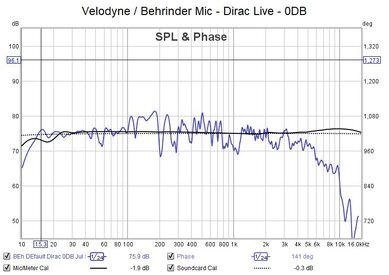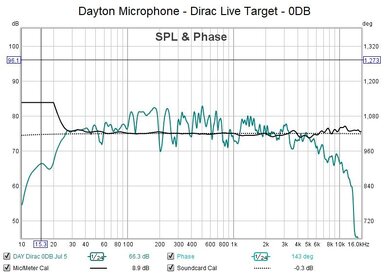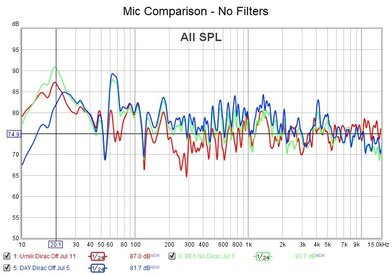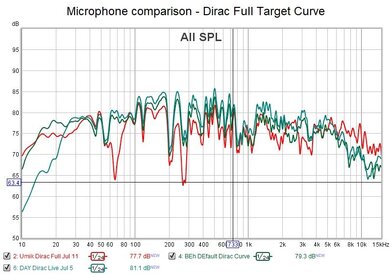Gregory Livingstone
Registered
Thread Starter
- Joined
- Mar 22, 2019
- Posts
- 27
Is the resulting frequency graph supposed to be adjusted by the microphone calibration data. I thought it would be, but now I'm confused. I tried my set up with a different microphone and calibration file. It shows a deeper frequency response.
I have been using REW with Dayton microphone & sound card. Today I also did the same measurements using Behringer microphone from SMS-1 kit. The measurements are both of a 2.1 system using a Dirac target filter lowered to put the lowest frequencies at 0DB. The only change is this microphone and the mic calibration file.
Looking at the calibration files the Dayton file's first entry is at 20 hz at 8.9 as the microphone calibration trace shows. The Behringer file starts at 10hz at -3.61051. If the frequency response trace does include the mic cal then one of the microphones is wrong or has an incorrect calibration file. For instance if the Dayton is flatter at the lower frequencies than the cal file indicates, it would falsely show roll off starting at 26 hz (not sure what happens below 20 hz).
Any thoughts as to how to confirm that one mic is more accurate than the other? I want to think that the Behringer is the more accurate, There are dual SVS SB3000 subwoofers on the .1 channel which should be better than -10dB at 20hz.
I am willing to get the recommended usb microphone, but think I still need a sound card as HDMI isn't a viable option. I presume using the laptop stereo out is a bad idea.If I go that route is there a sound card recommendation?
I have been using REW with Dayton microphone & sound card. Today I also did the same measurements using Behringer microphone from SMS-1 kit. The measurements are both of a 2.1 system using a Dirac target filter lowered to put the lowest frequencies at 0DB. The only change is this microphone and the mic calibration file.
Looking at the calibration files the Dayton file's first entry is at 20 hz at 8.9 as the microphone calibration trace shows. The Behringer file starts at 10hz at -3.61051. If the frequency response trace does include the mic cal then one of the microphones is wrong or has an incorrect calibration file. For instance if the Dayton is flatter at the lower frequencies than the cal file indicates, it would falsely show roll off starting at 26 hz (not sure what happens below 20 hz).
Any thoughts as to how to confirm that one mic is more accurate than the other? I want to think that the Behringer is the more accurate, There are dual SVS SB3000 subwoofers on the .1 channel which should be better than -10dB at 20hz.
I am willing to get the recommended usb microphone, but think I still need a sound card as HDMI isn't a viable option. I presume using the laptop stereo out is a bad idea.If I go that route is there a sound card recommendation?


















